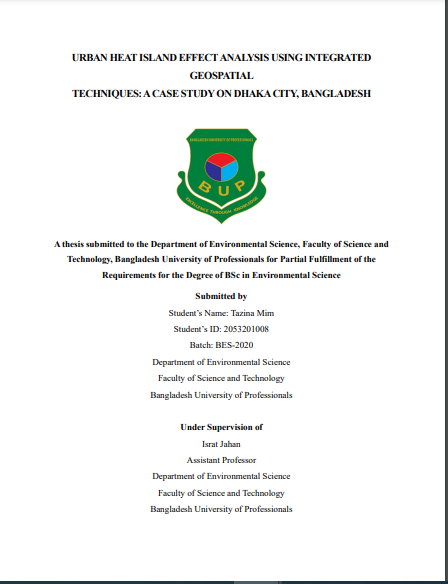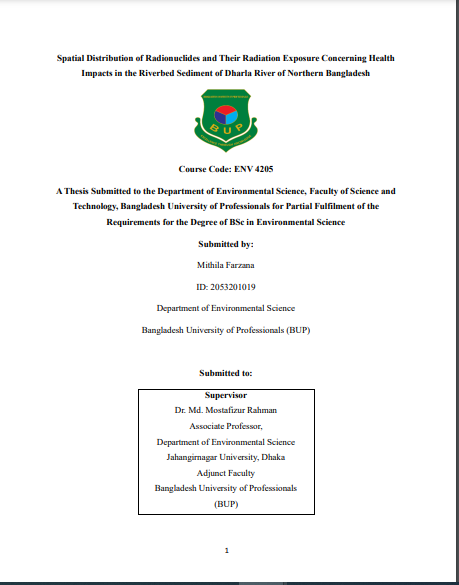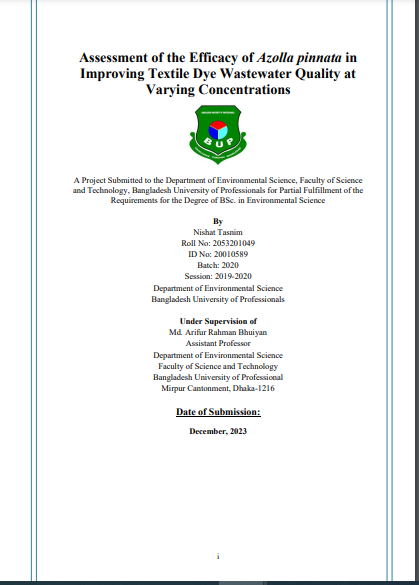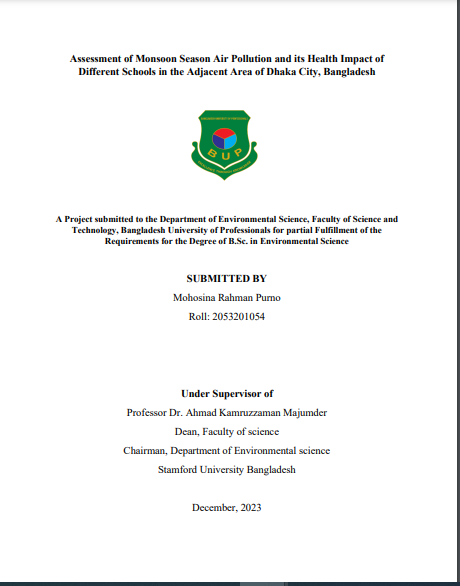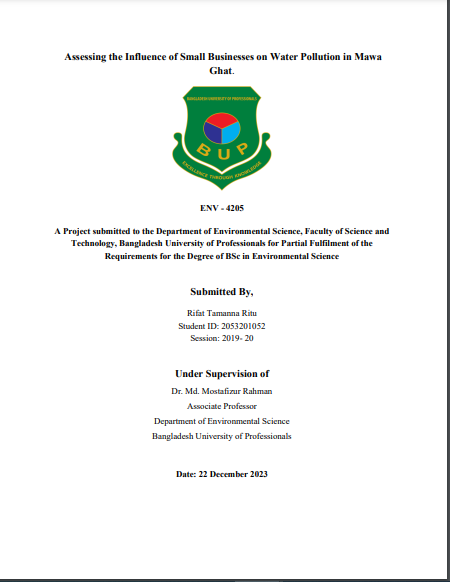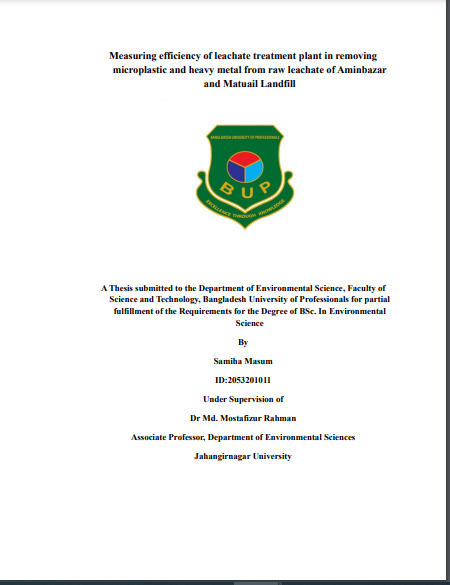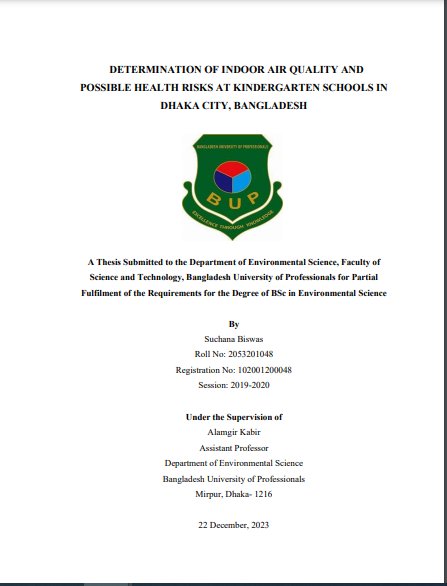
Executive Summary:
Indoor Air Quality & Health Risks in Dhaka Kindergartens. To Determination of Indoor Air Quality and Possible Health Risks at Kindergarten Schools in Dhaka City, Bangladesh. Air pollution is presently a typical word that we have acclimated with. Nonetheless, it’s a major global concern. One way to describe air pollution is as changes in the chemical composition of the atmosphere brought about by the introduction of chemicals, particles, or organic materials into the atmosphere.
Although these substances are already in the air, air pollution results when their concentration exceeds a natural limit. The adverse effects of exposure to air pollution are a global public health concern in both developing and developed nations. Children and young people are particularly vulnerable to the effects of air pollution because of its impact on physical and mental development which can cause health implications across the lifespan. Detrimental impacts from exposure to air pollution have been reported for early life health outcomes such as pregnancy outcomes, lung development and function, the central nervous system, life expectancy at birth, and infant mortality.
| Report Title : | Indoor Air Quality & Health Risks in Dhaka Kindergartens. |
| University Name : | Bangladesh University of Professionals |
| Submitted To : | Alamgir Kabir |
| Submitted By : | Suchana Biswas |
| Total Page : | 66 |
Furthermore, air pollution has also been reported to have adverse effects on mental development, language development, attention and sensory perception. The term “Indoor Air Quality” (IAQ) describes the quality of the air inside and surrounding buildings and other structures, with a focus on how it affects the comfort and health of building inhabitants.
IAQ is a component of indoor environmental quality (IEQ), which also covers other elements of the physical and psychological aspects of living indoors, like acoustics, lighting, and thermal comfort. Comfortable humidity and temperature, a sufficient supply of fresh outdoor air, and the management of contaminants both indoor and outdoor are all essential components of a healthy indoor air quality. The developed countries have been working with indoor air quality (IAQ) for many years. They identified the indoor air pollutants and investigated their impacts on health.
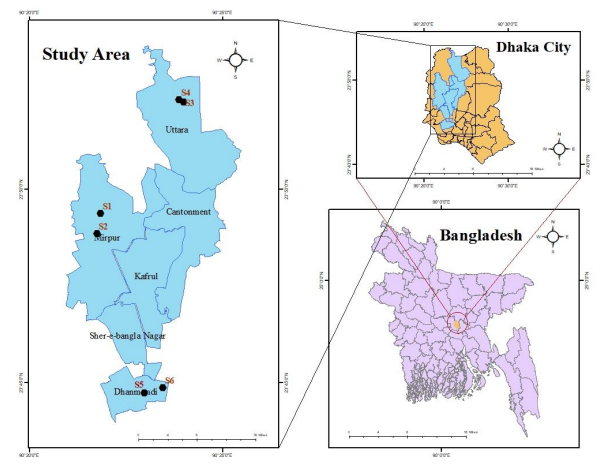
Outline of the Thesis
- Chapter One: Introduction–Background of the Study, Problem Statement, Research Gap, Rationale of the Study, Research Hypothesis, Research Question, Research Objectives, Broad Objective, Specific Objectives Definitions of Terms Used in Thesis.
- Chapter Two: Literature Review–Indoor Air Quality, Sources and Exposure of Indoor Air Pollutants, Health Effects on Children.
- Chapter Three: Methodology–Study Area, Research Design Data Collection, Instrument Required Machine, Statistical Analysis.
- Chapter Four: Results and Discussions—Results, Indoor Air Quality Assessment, CO2, Concentration, CO Concentration, NO2 Concentration, SO2 Concentration, O3 Concentration
PM2.5 Concentration, PM10 Concentration, Perception of Possible Health Risks, Concerns about Indoor Air Quality, Health Experiences, Household Smoking Habits, Facility Conditions, Environmental Factors, School Initiatives and Awareness, Recommendations and Additional Comments, Discussions, Overall Indoor Air Quality, Comprehensive Analysis of Survey Findings, Consideration of Roadside vs. Residential Disparities
- Chapter Five: Conclusions and Recommendations
Problem Statement
Poor indoor air quality is a significant public health threat, especially for young children in developing countries like Bangladesh & other developing countries. Rapid urbanization and uncontrolled growth have led to serious indoor and outdoor air pollution issues in the densely populated capital Dhaka. Most of the people are aware that air pollution from the outside can have an adverse effect on their health, but indoor air pollution can also be seriously hazardous.
According to EPA studies, Indoor air pollution levels can often be 100 times higher than outdoor levels, ranging from two to five times higher. The level of indoor air quality can significantly affect a student’s capacity to succeed in the classroom. Additionally, recent studies have revealed that poor indoor air quality may directly impact children’s capacity to study, in addition to contributing to illnesses that keep them from attending school.
Consistent data suggests that indoor air pollution raises children’s risk of acute respiratory infections and chronic obstructive pulmonary disease, which is the leading cause of death for children under five in developing nations. Hence, determining the indoor air quality of kindergarten schools in Dhaka city is necessary.
Research Objectives
Broad Objective
The broad objective of the study is to comprehensively assess the indoor air quality in kindergarten schools within Dhaka City, Bangladesh, with a specific focus on estimating potential health risks. Additionally, the study aims to investigate and compare air quality disparities between kindergartens located in roadside and residential settings.
Specific Objectives
- To determine the concentration of PM10, PM2.5, CO2, CO, SO2, NO2 and O3 in different kindergarten schools
- Examine the variation in indoor air quality between kindergarten schools located in roadside and residential areas of Dhaka City 6
- Investigate potential health risks associated with identified air pollutants among kindergarten students
Conclusion
The thesis report underscores the critical importance of addressing indoor air quality (IAQ) in kindergarten schools in Dhaka City, Bangladesh. Rapid urbanization, unregulated growth, and dense urban environments have exacerbated air pollution challenges, posing significant health risks to young children, a vulnerable demographic.
This highlights the urgent need for targeted interventions to mitigate exposure risks. Recommendations include implementing effective IAQ management practices, increasing awareness among stakeholders, and developing policies to improve indoor environments in educational settings.
